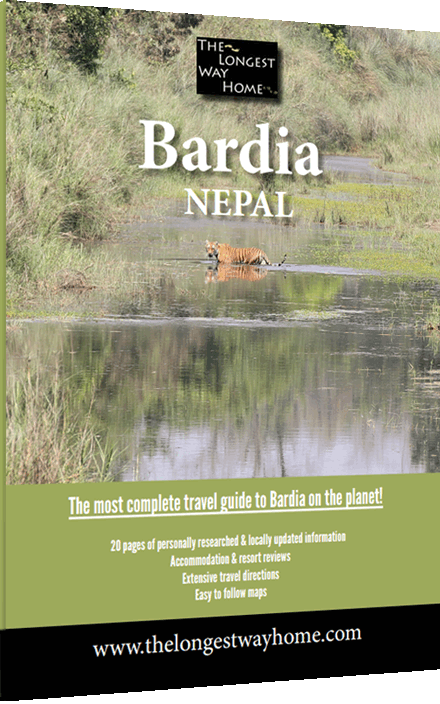About Bardia National Park
The area around and including Bardia National Park (Bardiya) dates back to before 1815.
It was one of the few areas that was a part of Nepal before the Sugauli Treaty when the British East India Company handed back control to Nepal.

It's not a commercial tourist spot. There are no frills in Bardia unless you stay in a top resort. Meanwhile, mid to budget resorts all offer similar types of accommodation.
Bardia does not compare to the popular Chitwan National Park in terms of commercial tourism. A visit to Bardia for the average tourist is one of adventure and real jungle treks with few other people around.
Regular records on Bardia’s history began in the 1960’s when 368 sq kms were set aside as royal hunting grounds. In 1982, the area was officially named “Royal Bardia Wildlife Reserve”. In 1984, it was joined by the Babai valley, which combined is what we have today. Bardia is an important wildlife conservation area that suffers from poaching. On the plus side, Bardia has had success in increasing animal populations naturally.
Animals in Bardia National Park
Bardia contains countless deer who are the primary source of food for the tiger population, which is one of the highlights in Bardia. Although there are fewer Royal Bengal Tigers in Bardia than in Chitwan, you have a greater chance of seeing them here. Fish are a major source of food for the 250 plus types of birds found in the area. Bardia’s largest attractions are also its largest inhabitants. Tigers, elephants, and rhinos all roam through the jungle landscape. There's a huge amount of deer, jungle cats (including elusive and rare leopards), plus many monkeys.
Getting to Bardia
Here's my complete travel guide to getting to Bardia National Park, including bus times from different cities, transfers, and costs: How to get to Bardia National Park.
Contents
» About Bardia National Park & how to get there
» Best time of year for visiting Bardia
» Things to do at Bardia National Park & the costs
» Best way to see a Rhino in Bardia
» Best way to see a Tiger in Chitwan
» Full map of Bardia National Park
» Understanding Bardia ticket pricing
» Where to stay in Bardia National Park
» Dangers in Bardia National Park
» Tips for saving money at Bardia
When is the best time of year to visit Bardia?
Bardia National Park is open year-round with most wildlife visible.

However, it's at the end of the dry season and the start of the hot season, from February to July, that there is a greater chance of seeing tigers as they come out to the waterholes.
This is Nepal's official "off-season" in regards to trekking. Local guides also mention November and December as being good times, though it's not that hot and can be very hazy.
Do note that from March to July, it is very hot in Bardia, so do come prepared and stay hydrated.
If you are planning to visit Bardia National Park, be prepared for a long bumpy bus journey to reach the it. The bus ride can be hot and uncomfortable, especially during the summer months. To stay cool on the bus, dress in light and breathable clothing. Make sure to carry enough water with you.
Things to do at Bardia National Park
Unlike Chitwan National Park, activities in Bardia are largely limited to jungle and wildlife exploration. Guides are mandatory, as are national park tickets. Again, please realize that Bardia offers a raw, untamed jungle experience and is not a commercial "safari" style park. While Bardia does offer a better chance at seeing a Royal Bengal Tiger in the wild, there are no guarantees at all. It's all about the experience. Choose between half-day, full-day, two/three-day, one-week, or private jungle treks. You can go in a group or alone (with a guide). Costs usually include meals. In many cases, a resort will provide a packed lunch/dinner. Prices start from around 3,000 rupees for a half-day tour to 4,000 for a full day tour based on 1 person. If there are 4 or more, then expect prices to be around 3,500 per person. So yes, you can share the price between you. Otherwise, if alone, it will cost you a little more. But do shop around as you will get cheaper rates which are also dependent on the season. What you can expect to see? depending on the time of year. Half-day tours usually only end up seeing jungle, Rhesus monkeys, and a few birds. If you are lucky, a Rhino may be bathing. To be honest, it's not worth going all the way to Bardia just for a half-day tour. Full-day tours will have a greater chance at seeing a rhino, wild elephants, birds, other wildlife, and a tiger. Overnight tours that go deeper into the jungle have very good chances of seeing a rhino and a good chance of seeing a tiger. Jeep tours are offered for those wanting to go deep into the jungle quickly where the chances of seeing a tiger are greater. They are often mixed with day trek excursions and packages. Prices are generally around USD $170 per day inclusive of accommodation and food. 2/3 day package tours are often better value but only if you book in person in Bardia once you get there rather than online where the prices get slightly crazy. Elephant treks in Bardia are becoming rare and largely discouraged. They are offered by some of the larger resorts, and there is little exploration in the jungle. They generally last between 1 and 1.5 hours and are substantially more expensive than in Chitwan, where they still offer elephant rides due to many of the park rangers using them to help patrol the area. Note: All jungle treks require a National Park ticket - details on fees below. Located on the boundary of the National Park is the Elephant breeding center of Bardia. Entrance prices are 50 rupees for a foreigner (westerner), 25 SAARC, 10 Nepalese. Opening hours are 10 am to 6 pm, though generally it's best to visit around 10 am before elephants leave for the day on patrols. Located close to the entrance of the National Park is the Crocodile breeding center of Bardia. If you've already seen gharial crocodiles or marsh muggers in the wild, you may want to give this a skip. Otherwise, it's a quick visit. Right beside the crocodile breeding center is a small Tharu museum. Costing 50 rupees to enter, you'll get to see various indigenous artifacts ranging from kitchenware to farming tools along with some Tharu history signboards. Quite why both the breeding center and the Tharu museum are not included in the main ticket price is a bit baffling. Still, if you've not visited a Tharu village, it's worth a look. An alternative to the museum is to visit a Tharu village either by a 400 rupees tour or by heading off yourself from Thakurdwara or by bicycle. Big resorts offer river expeditions, while smaller resorts can organize the same if you book through them. Rafting/boating takes place on the Geruwa River where you will see crocodiles, bird-life, and maybe a tiger or rhino. Do exercise extreme caution when on the water as crocodiles do inhabit the rivers and are deadly. Swimming is therefore highly discouraged. 15,000 rupees gets you a full day out in a canoe with a packed lunch provided and a guide. The golden mahseer is what many people fish for along with goonch. You can alternate boat fishing and riverside fishing throughout the day. All fish must be put back in the river. In 2024, river boats have been difficult to find due to excessive permit charges to curb illegal fishing. Spotting the one-horned Indian Rhinoceros in Bardia is not as easy as it is in Chitwan due to lesser numbers. The best times to see a rhino is early in the morning or late in the afternoon when they come out to the watering holes or in the hot season when they want a swim. They generally disappear into the jungle during the mid-day heat. Due to their lack of numbers, you'll usually only spot a lone rhino. Again, exercise caution as rhinos can be aggressive and deadly with an excellent sense of smell and hearing.Jungle walks/trekking

Jeep Jungle tours
Elephant rides
Elephant breeding center
 It's smaller than Chitwan's breeding center and is not as educational. Elephants range from injured or sick elephants to newborn and park patrol elephants.
It's smaller than Chitwan's breeding center and is not as educational. Elephants range from injured or sick elephants to newborn and park patrol elephants.Crocodile breeding center
Tharu Museum / Tours
River boating and fishing in Bardia
Best way to see a rhino in Bardia
Jungle treks to spot a rhino
Best way to spot a tiger in Bardia
Tigers in the hot season are seen at watering holes
There's a greater chance of spotting a Royal Bengal Tiger in Bardia than in Chitwan. It's not a guarantee though. If this is your ultimate goal when visiting Bardia, then come without a fixed date to leave. Again, guides are mandatory, do not attempt to go into the jungle alone.
Good jungle guides know where tigers are in Bardia depending on the season. Either breeding pairs, nursing mothers (avoid), or solitary tigers known to be hunting in the area.
Keep your ear to the ground in terms of listening to your guide or resort. If there have been tiger sightings over a few days, then that's a good time to get to Bardia. It's a waiting game, and the tiger is the timekeeper.
Always follow your guide's instructions. Tigers attack from behind, so you should always go with two guides, with the trainee guide taking up the rear.
If attacked or if you come face to face with a tiger, gathering in a group with sticks is your best chance. Climbing a tree is the next best option. Just remember that tigers can climb too.
Be cautious when guides mention that there are tiger cubs nearby, as this means there will be a very protective mother nearby too.
Full detailed Map of Bardia National Park
Understanding Bardia entrance fees and tickets
Please note that it's Nepal, and prices often change without notice.
You do not need a ticket to enter Ambassa or Thakurdwara
Thakurdwara is a town outside of the park. There has never been a fee to enter the village. Thakurdwara is where the majority of people stay when visiting Bardia National Park. There is a daily direct bus from Kathmandu to Thakurdwara since 2018. Otherwise, you can take a bus to Ambassa and then go to Thakurdwara.
Bardia National Park ticket prices
Thakurdwara is where the Bardia National Park Headquarters and ticket office are located. Tickets cost 1500 rupees per person per day, which includes tax.
The ticket is valid for one day only.
Official tickets are available at the National Park ticket office, which is just inside the big gates to the south of Thakurdwara where there's a junction (take a right, cross the bridge).
Please note that it is mandatory to have a guide in Bardia National Park, so you might as well let your guide deal with getting a ticket!
Where to stay in Bardia National Park
Should you stay inside Bardia Park or outside Bardia Park?
Understand that lodges are banned from operating inside the park jungle so don't believe anyone who tells you that their accommodation is inside the park.
Staying outside Bardia National park means you will be staying outside the main gates in the buffer zone but also outside of Thakurdwara town (let's call it an accommodation buffer zone). Bardia has a wide selection of resorts that vary in price from $5 per night upward to $150+.
Most travelers book ahead and arrange jungle treks or excursions from there.
Here's is search tool to find resort accommodation in Bardia.
If you'd like to use the same guide and resort I did they are listed in my guidebook to Bardia which is also included in my guidebook to Nepal.
Dangers in Bardia National Park
Bardia National Park is a tropical jungle with active and dangerous wildlife. In 2016, there was a tiger attack on a Dutch tourist [[1]]. The dangers in Bardia National Park are very real, so take caution at all times.
Dangerous animals in Chitwan
Tigers, elephants, crocodiles, snakes, and rhinos top the list of dangerous animals in Bardia.
Good trekking guides will advise you on what to do in the event of an encounter with a wild tiger, crocodile, elephant, snake, rhino, and sloth bear. Take note, seriously.
Tigers usually attack from behind. That's why there's usually a trainee guide to your rear at all times.
Avoid trekking alone in the jungle at all costs (wandering off, toilet breaks, etc.). Avoid bathing in the rivers. Stay quiet in the jungle. Many guides complain that bringing very small and/or loud children into the jungle or on elephant treks is not a good idea. I would agree. Do not wear deodorant or cologne in the jungle.
Malaria and Dengue in Bardia
Mosquitoes are ever-present in Bardia. Outbreaks of Dengue do happen, and Malaria, though not prevalent, does exist. Take precautions not to be bitten and try to ensure your bed has a mosquito net.
Tips on saving money at Bardia National Park
What's cheaper? Arranging everything independently or taking tours to Bardia?
Again, Bardia is not Chitwan, nor is it Kathmandu or Pokhara. It's not realistic to just show up with a bag and wander around resorts looking for the best options. Think of it as the wild jungle of Bardia.
That said, booking a full package tour online to Bardia is expensive. Booking a night's stay, however, is not.
Bardia does not have the commercial aspect that Chitwan has, and many tour operators can't make a profit taking people to Bardia, so they opt for Chitwan instead. It's closer, has more hotels, and gives them more profit.
Keep this in mind if you are looking for a package trip from Kathmandu, as many agents will try to persuade you to opt for Chitwan instead.
Is it cheaper to get a package tour to Bardia from Kathmandu/Pokhara/Online or get one once I arrive?
Due to transport options, it's better and cheaper to book a room at a resort online but not make a commitment to a jungle trek until you arrive.
This way, you've already booked a night or two at a resort, so you can be sure they will pick you up at Thakurdwara and bring you to the park. From there, you can bargain for a jungle trek, etc. If the resort is not to your liking, you can always go for a walk to find another nearby (this option will only work if you are staying close to the National Park - details in my guidebook).
If you decide to use another guide rather than your resort's, then it's probably best to move to the guide's resort too. It's a very small community, and this keeps the peace.
Bardia National Park or Chitwan National Park?
If you had a choice, would you visit Chitwan or Bardia?
This is a question I get a lot. It really depends on what you want and, of course, how much time you have.
If you want to have fun with elephants, go on jungle treks with a good chance of spotting wild rhinos, and enjoy dining out at night, then Chitwan is the place for you. This is especially true if you are short on time.
If you are looking for a more natural setting, deep in the jungle, with a stronger chance of seeing a wild tiger and observing elephants in their natural environment, then Bardia is the place for you.
Download my full travel guidebook to Bardia National Park
Curious to explore the depths of Bardia National Park? Discover every nook and cranny with my extensively detailed travel guide to Bardia!
This guidebook covers everything from complete transportation insights, up-to-date pricing around the park, in-depth reviews of accommodations, to high-resolution maps, and much more.
Experience a unique travel companion with an interactive & printable guidebook unlike any other.
Interested in more adventures? Secure your journey with my complete guidebook to Nepal (including a special section on Bardia)
Was this page helpful to you? If so please tell others!



